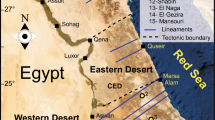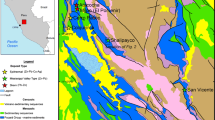Abstract
The Finero peridotite massif is a harzburgite that suffered a dramatic metasomatic enrichment resulting in the pervasive presence of amphibole and phlogopite and in the sporadic occurrence of apatite and carbonate (dolomite)-bearing domains. Pyroxenite (websterite) dykes also contain phlogopite and amphibole, but are rare. Peridotite bulk-rock composition retained highly depleted major element characteristics, but was enriched in K, Rb, Ba, Sr, LREE (light rare earth elements) (LaN/YbN = 8–17) and depleted in Nb. It has high radiogenic Sr (87Sr/86Sr(270) = 0.7055–0.7093), low radiogenic Nd (ɛNd(270) = −1 to −3) and EMII-like Pb isotopes. Two pyroxenite – peridotite sections examined in detail show the virtual absence of major and trace element gradients in the mineral phases. In both rock types, pyroxenes and olivines have the most unfertile major element composition observed in Ivrea peridotites, spinels are the richest in Cr, and amphibole is pargasite. Clinopyroxenes exhibit LREE-enriched patterns (LaN/YbN ∼16), negative Ti and Zr and generally positive Sr anomaly. Amphibole has similar characteristics, except a weak negative Sr anomaly, but incompatible element concentration ∼1.9 (Sr) to ∼7.9 (Ti) times higher than that of coexisting clinopyroxene. Marked geochemical gradients occur toward apatite and carbonate-bearing domains which are randomly distributed in both the sections examined. In these regions, pyroxenes and amphibole (edenite) are lower in mg## and higher in Na2O, and spinels and phlogopite are richer in Cr2O3. Both the mineral assemblage and the incompatible trace element characteristics of the mineral phases recall the typical signatures of “carbonatite” metasomatism (HFSE depletion, Sr, LILE and LREE enrichment). Clinopyroxene has higher REE and Sr concentrations than amphibole (amph/cpxDREE,Sr = 0.7–0.9) and lower Ti and Zr concentrations. It is proposed that the petrographic and geochemical features observed at Finero are consistent with a subduction environment. The lack of chemical gradients between pyroxenite and peridotite is explained by a model where melts derived from an eclogite-facies slab infiltrate the overhanging harzburgitic mantle wedge and, because of the special thermal structure of subduction zones, become heated to the temperature of the peridotite. If the resulting temperature is above that of the incipient melting of the hydrous peridotite system, the slab-derived melt equilibrates with the harzburgite and a crystal mush consisting of harzburgite and a silica saturated, hydrous melt is formed. During cooling, the crystal mush crystallizes producing the observed sequence of mineral phases and their observed chemical characteristics. In this context pyroxenites are regions of higher concentration of the melt in equilibrium with the harzburgite and not passage-ways through which exotic melts percolated. Only negligible chemical gradients can appear as an effect of the crystallization process, which also accounts for the high amphibole/clinopyroxene incompatible trace element ratios. The major element refractory composition is explained by an initially high peridotite/melt ratio. The apatite, carbonate-bearing domains are the result of the presence of some CO2 in the slab-derived melt. The CO2/H2O ratio in the peridotite mush increased by crystallization of hydrous phases (amphibole and phlogopite) locally resulting in the unmixing of a late carbonate fluid. The proposed scenario is consistent with subduction of probably Variscan age and with the occurrence of modal metasomatism before peridotite incorporation in the crust.
Similar content being viewed by others
Author information
Authors and Affiliations
Additional information
Received: 20 July 1998 / Accepted: 28 October 1998
Rights and permissions
About this article
Cite this article
Zanetti, A., Mazzucchelli, M., Rivalenti, G. et al. The Finero phlogopite-peridotite massif: an example of subduction-related metasomatism. Contrib Mineral Petrol 134, 107–122 (1999). https://doi.org/10.1007/s004100050472
Published:
Issue Date:
DOI: https://doi.org/10.1007/s004100050472




